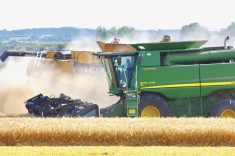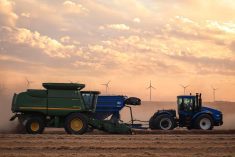It’s a relatively new solution to the age-old problem of trying to get rid of weeds without broadcasting the seed or using increasingly less effective herbicides — mechanical separation and pulverization of weed seed.
Harvest weed seed control might not be a golden bullet to tackle glyphosate-, fluroxypyr- and dicamba-resistant weeds, but according to Agriculture and Agri-Food Canada researcher Breanne Tidemann, it’s part of the range of solutions needed to stem the tide.
Read Also

Pulse Weekly: No upside for peas until after New Year
Prices for green and yellow peas have dropped back across the Prairies over the last week. One of the major downward drivers was the Statistics Canada production report released earlier this month, said Levon Sargsyan of Johnston’s Grain in Calgary.
“You’re not going to spray your way out of this,” Tidemann said about herbicide resistance during her presentation at Ag in Motion.
“If you get a new product or new mode of action that works really well, everyone is going to adopt it, the selection pressure is going to go through the roof and we’re going to break that next tool, too. So, continuing to hope, cross our fingers, wishing and praying a new product is going to come out and save us is a little bit naïve, a little wishful thinking.”
However, the ability to mechanically separate weed seed at the point of harvest is part of the diversification solution that looks beyond just chemicals.
Development of harvest weed seed control started in the early 2000s in Australia before moving onto commercialization with the Harrington Seed Destructor trailer unit.
There are limitations to the implement, mainly that the weeds need to be either tall or short enough to fit in the header. However, once they do, the weed seeds are largely ground up into a flour-like material, doesn’t broadcast and can be an effective tool in not only limiting spread but getting to the core of the issue. As long as weeds are harvested, seed destructors have a more than 95 per cent rate of success.
Canadian research with the unit began in 2014, but since then, integrated harvest weed seed control implements for combines have been developed and are now commercially available.
While initial research is promising in demonstrating the implement will have significant impact on both weed control as well as limiting broadcast, weeds will likely be able to adapt even to mechanical attempts at tackling weeds.
“Weeds will adapt. Weeds are dirty little buggers that will find some way — they’ll mature more quickly, they’ll drop there seeds earlier, they’ll become more prostrate,” said Tidemann.
“We’ll see adaptations, I firmly believe that, particularly if we switch whole hog from only herbicides to only relying on this.”
She said it’s about redundancy, adding the solution is to use a range of techniques.
As far as where the technology goes next, Tidemann said the speed in which it’s already progressed is impressive and manufacturers of weed seed harvest control implements are continually improving the product.
“They are really listening to farmers,” she said.
“A farmer will say, ‘I had a problem with a metal bolt going through and it damaged my mill, I had to do a lot of repairs.’ The next thing you know, they’ve got a magnetic strip to catch metal pieces before they go through the mills.”
As development work continues, Tidemann said she hopes the technology is more widely adopted in Canada.
“My understanding from talking to colleagues (in Australia) is 80 to 90 per cent of their farmers are using some form of harvest weed control,” she said.
“Western Australia is showing it can be incorporated into a system and it can help and it can work.”
There is a cost, with units running in the $100,000 range, but Tidemann said it’s likely less than what farmers might think because it can be used on one combine that can tackle particularly weed patches rather than being required on every combine.
— Alex McCuaig reports for the Western Producer from Medicine Hat.
















